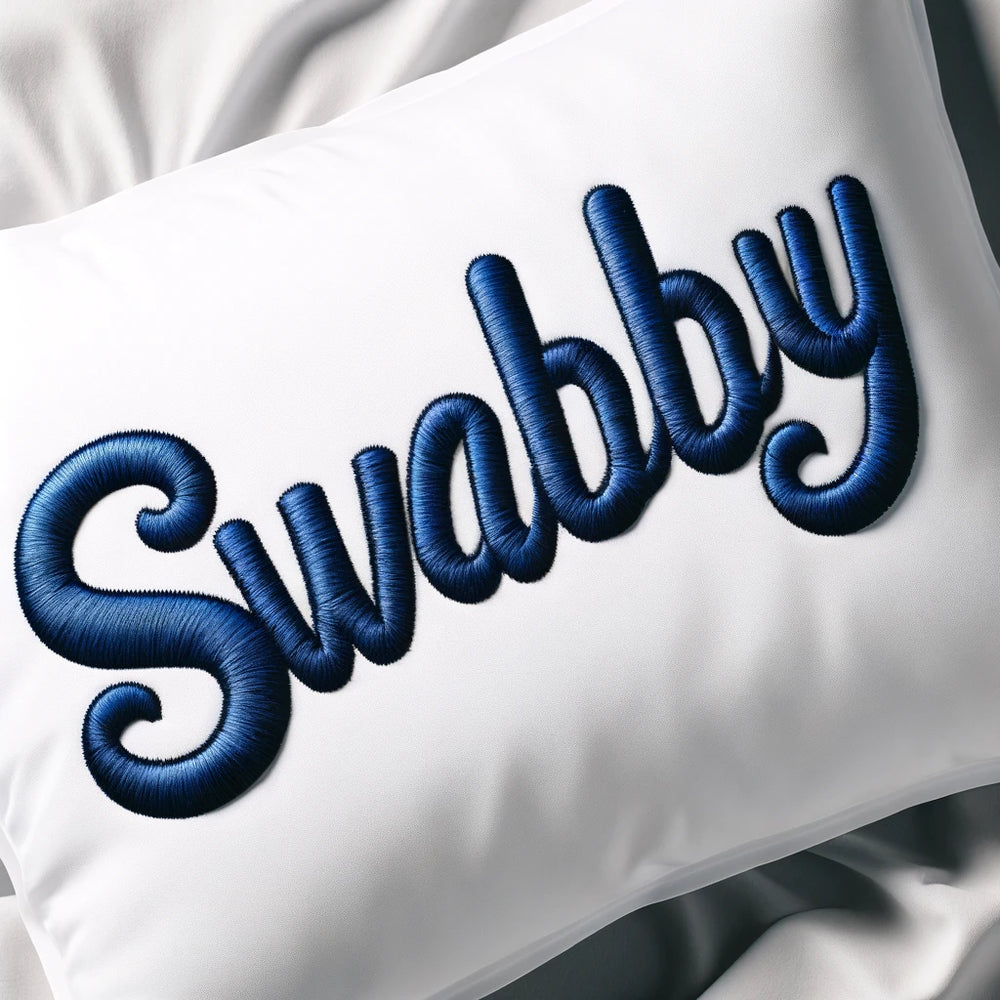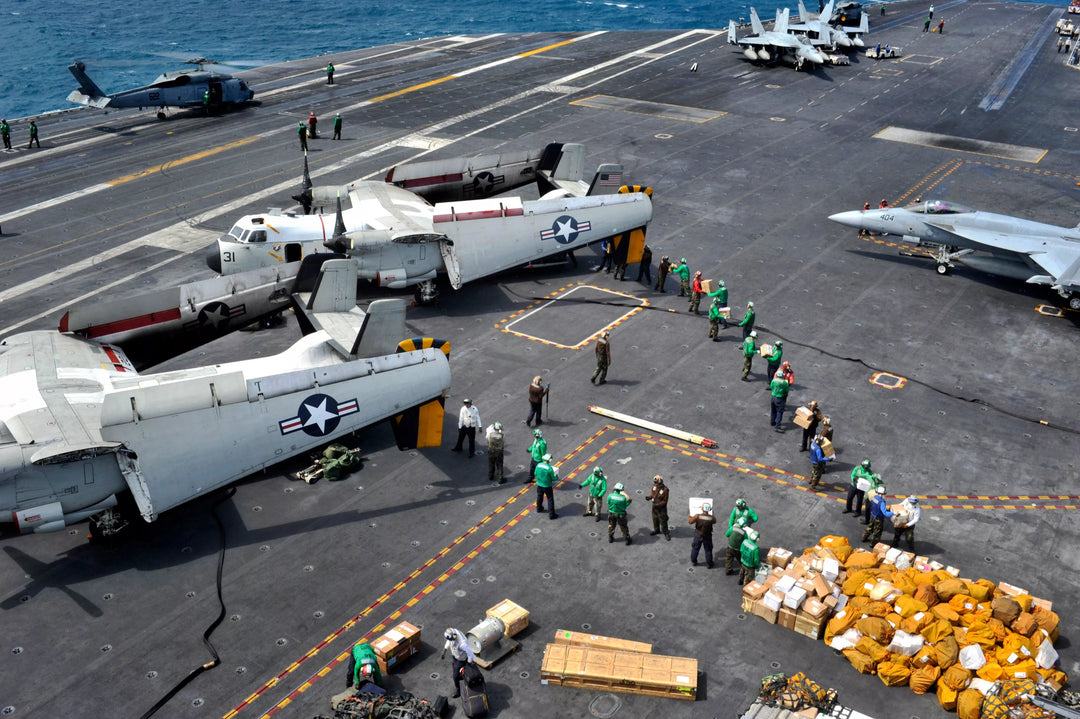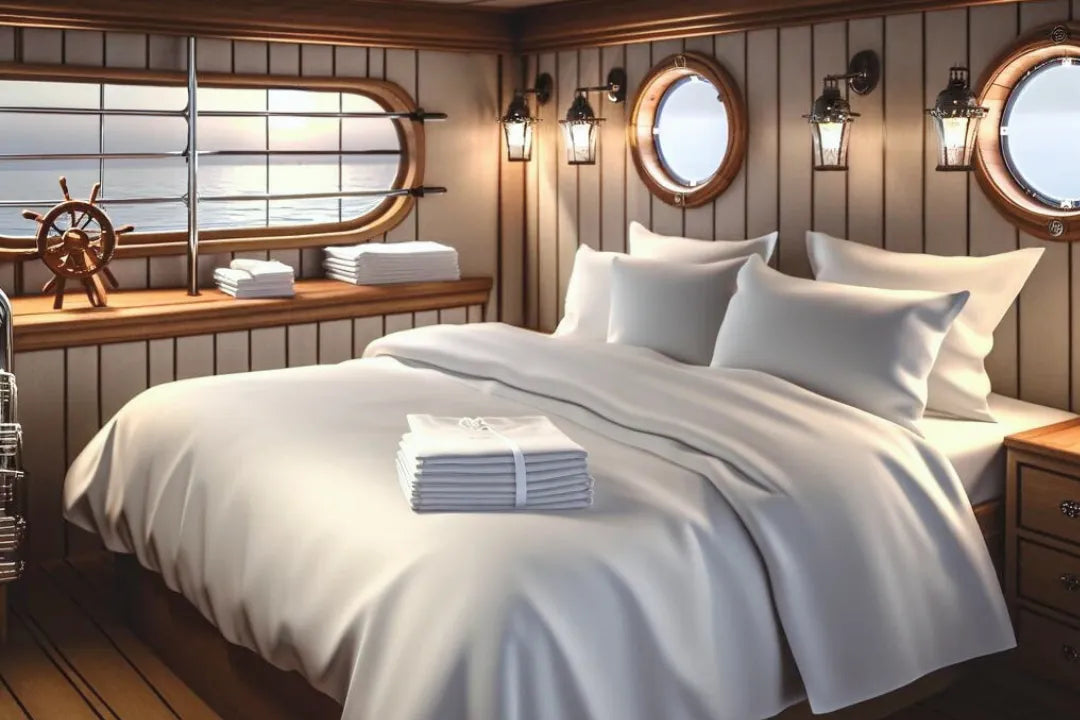Shipboard Living: Then and Now

It’s a naval tradition that hasn’t changed since our ancestors first set out to sea: we sailors will always find a way to complain about shipboard living conditions. Even in the most modern and spacious shipboard accommodations, we’ll use our most colorful language to describe what we’re forced to endure while at sea. But it’s with good reason: this is how we live.
The Ancient World
How bad shipboard living actually depends on the era, though. Let’s start way back: imagine being a crew member aboard a trireme in Ancient Greece. You’d be one of 170 oarsmen, with no space to do anything but sit your butt on a bench and row in time. With that much raw power behind three banks of oars, a trireme covered about 40 miles in a day!
That’s an impressive feat and all, but with no space onboard to rest or prepare food, crews had to put ashore every evening. Around the Eastern Mediterranean and Black Seas, popular stopover points sprang up where the sailors and marines had the best luck in foraging for food and finding a soft rock to rest heads on.
Of course, if the mighty tired crew was unable to put ashore, they would have had to rest on their rowing benches, which probably meant lots of leaning on shoulders, cuddling close, and someone having the privilege of nosing up against stinky feet.
Unfortunately, none of the Ancient Greeks’ seagoing jargon of the time survived. We’re left to imagine how those surly seagoing oarsmen would have described sleeping over their oars, surrounded by odorous shipmates who didn’t bathe. Ever.
Viking Longships
The Vikings gave us the word “berserk.” Before they raided a town or village, these berserkers would dress in bear (ber) skin, worn like a shirt (serkr). Using beer and Nordic religious rituals, they worked themselves into a trance-like rage before the attack.
It’s totally understandable why, too. Their awesome and mean-looking longships didn’t even have rowing benches! Oarsmen sat on their sea chests, and unlike the sunny Mediterranean, there was no use going ashore in search of comfort in the cold of the North Sea. Instead, these Nordic sailors spent their days and nights and weeks at sea sleeping on a plank deck, grabbing whatever furs and wools they could, and eating nothing but dried fish and beef. That would make anyone want to go berserk.
And don’t even try to take those longships on long voyages: they fared poorly in regular seas and were thoroughly thrashed by Aegir in heavy seas. Of the 27 ships Eric the Red took on his voyage to Greenland, only half made it.
Living on Tall Ships
On the tall sailing ships borne of the Renaissance, the crew slept on the mess deck. On crappy and totally unsanitary straw-stuffed ‘mattresses’ or a pile of wool blankets (you can imagine what it’d be like with water below decks). As the ships tossed about in heavy seas, the crew did, too: injuries were common. Unless you were an officer, sleeping in a stateroom bunk, with a lantern and a good book, of course. We’re pretty sure that was the sole reason for all mutinies ever.
For longer voyages (you know some of these went around the world, right? Like over the course of years), the main staple was heavily salted beef and pork, which the crew soaked in brine (read: seawater) to try to make it palatable. That’s right: the sailors dipped their meat in the ocean so they could eat it. Many of them would chew a single piece of meat for hours, sitting around in groups “chewing the fat.”
Hammocks and Hardtack
Once Columbus landed in what is now the Bahamas, he saw locals lounging about in netting and started asking questions. Turns out, they’d been using hammocks for hundreds of years as a way of elevating above snakes, rats, and other vermin that’s generally a bad idea to sleep with.
The sailors quickly adopted hammocks for shipboard use. By 1690, the British Royal Navy had adopted hammocks as the standard in sleeping arrangements for sailors. You can imagine the ads: While out to sea, enjoy the cozy comfort of our naval hammocks wrapped around you like a cocoon, swaying gently in time with the sea, while shipping while officers wedge themselves into bunks to keep from being tossed about. Enlist today!
And, as it had been for thousands of years, hardtack remained a staple. The British Royal Navy began mass-producing hardtack in the mid-17th century. The recipe was flour, salt, and water. To make it last on a long voyage, they removed all the moisture, sometimes baking it four times. Sailors referred to these unpalatable but sustaining sea biscuits as “molar breakers.” They soaked them in tea or brine to make a sort of mush (yum!).
Accounts of life at sea describe sailors rapping their hardtack, a/k/a “worm castles” on the table or deck to knock the weevils out of it.
The cook wasn’t a regular position, either. Instead, whatever injured crew member was unfit for regular duty was assigned to feed the hungry masses. Considering what their culinary skills might have been explaining why shipmates coined the phrase, “God made the vittles, but the devil made the cook.”
“All Hands Heave Out and Trice Up”
The hammock was a U.S. Continental Navy standard issue item, along with two wool blankets and a thin mattress. Luxury had finally arrived at sea!
Every morning, the crew removed their hammocks from hooks, rolled them up with the bedding inside, and triced them up using seven half-hitch turns. They secured them to the rail to help protect it from cannon shot ("Lash and Stow!"). The hammocks were also useful as damage control material.
They even served as burial shrouds! The last turn in lashing the shroud was through the nose to make sure the sailor was dead - one of many longstanding nautical superstitions .
Steam Power
Some steel ships of the late 19th and early 20th century were a step backward in terms of comfort. The main berthing space was amidships, near the machine shops and above the fireroom. While ashore, that’s all well and good, but once underway, those berthings became a smelly noisy hellhole of discomfort. A.P. Niblock described the disconnect between berthing inspections and actual conditions eloquently:
“In port in such ships for distant and prolonged service as cruisers, the air-ports are not closed, the ice-machine is not rattling away, the blower engines are not humming, the ash-hoists are not buzzing, the dynamos are interesting, and the distiller is temporarily out of use. Put all these in the living spaces, add the phenomenal heat of modern fire-rooms, and the noise, oily smell, cramped berthing space, bad air, and consequent loss of sleep, and the picture is that of ordinary cruising at sea. Prolong this for months and it means sickness, discomfort, and inefficiency of the crew.” -- Ensign A.P. Niblock, USN. "The Enlistment, Training, and Organization of Crews for Our New Ships." United States Naval Institute prize essay for 1891. Naval Historical Foundation Publication.
From Canvas Racks to Coffins to Showers
In the early 20th century, canvas racks stretched on metal tube frames began to replace hammocks, but hammocks remained in service on many ships until well after WWII. It was in the Vietnam War, aboard the USS Long Beach (CG-9) and USS Sacramento (AOE-1) that the canvas racks gave way to the now-familiar metal frame box we call the “coffin.”
In more recent designs, the installation of self-service laundry facilities has done away with the need for a laundry queen. Now you get to choose what color your skivvies will be when they come out of the wash.
On the new Gerald R. Ford (CVN-78), each berthing space on has an attached head and showers. You no longer have to bumble down the passageway in a towel.
Technology has enabled smaller crews and, thankfully, more space. On Ford-class carriers, berthing areas have a maximum of 40 racks, instead of 180 as on the Nimitz class. On some of the new combat ships, the maximum number of racks in a berthing compartment is twelve. And in the name of naval tradition, an important design feature has been retained: the headroom is still about 18 inches, so you can’t tuck in a sheet without bumping your head.
Shipboard living ain’t bad all the time, though. We always have each other to make fun of.
References & Further Reading
Horn, Theodore, 1962. The Fall of Athens: Selections from the Hellenica of Xenophon. McMillan and Co. Ltd.
“The Vikings.” Royal Museums Greenwich (Retrieved October 06, 2015).
“Hammock Lore and History.” Nicamaka / Buy Hammocks (Retrieved October 9, 2015).
“Hard to Swallow – A Brief History of Hardtack and Ship’s Biscuit.” Military History Now. Retrieved October 4, 2015.
Muir, Margaret. "Cooking on wooden sailing ships in the 1700s and 1800s ." Blog of Margaret Muir, Author (November 21, 2012.)
Cutler, Thomas J. A Sailor's History of the U.S. Navy. U.S. Navy Institute Blue & Gold Professional Library, Naval History and Heritage Command.
“New Carrier Boasts Better Berthing, Shorter Chow Lines.” Navy Times (November 8, 2013).
“The Origins of Navy Terminology.” Mobile Riverine Force Association (Retrieved October 9, 2015).
“Christopher Columbus’ Santa María.” The Mariner’s Museum (Retrieved October 10, 2015).
“Annual Report of the Surgeon General of the U.S. Navy, Fiscal Year 1910.” Online at Google Books. Naval History and Heritage Command (Retrieved October 1, 2015).
John McCoy
Master Chief Petty Officer, Retired & Copywriter
mccoywrites.com








Leave a comment